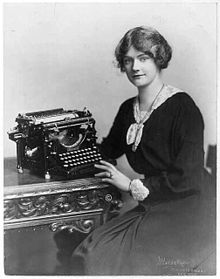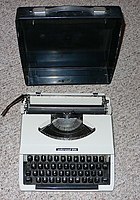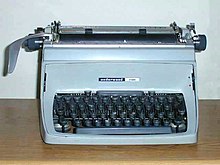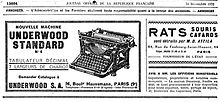Underwood Typewriter Company
| Company type | Private company |
|---|---|
| Industry | Business machines |
| Founded | 1895 |
| Founder | John T. Underwood |
| Defunct | Acquired by Olivetti (1959)[1] |
| Headquarters | , United States |
Key people | Franz X. Wagner, "Front strike" Inventor John T. Underwood, Namesake/founder |
| Products | Typewriters |
The Underwood Typewriter Company was a manufacturer of typewriters headquartered in New York City, New York. Underwood produced what is considered the first widely successful, modern typewriter.[2] By 1939, Underwood had produced five million machines.[3]
History


From 1874, the Underwood family made typewriter ribbon and carbon paper, and were among a number of firms who produced these goods for Remington. When Remington decided to start producing ribbons themselves, the Underwoods opted to manufacture typewriters.[2]
The original Underwood typewriter was invented by German-American Franz Xaver Wagner, who showed it to entrepreneur John Thomas Underwood. Underwood supported Wagner and bought the company, recognising the importance of the machine. Underwood No. 1 and No. 2s, made between 1896 and 1900, had "Wagner Typewriter Co." printed on the back.[2]
The Underwood No. 5 launched in 1900 has been described as "the first truly modern typewriter". Two million had been sold by the early 1920s, and its sales “were equal in quantity to all of the other firms in the typewriter industry combined”.[4] When the company was in its heyday as the world's largest typewriter manufacturer, its factory at Hartford, Connecticut was turning out typewriters at the rate of one each minute.
Underwood started adding addition and subtraction devices to their typewriters in about 1910.
Philip Dakin Wagoner was appointed president of the Elliott-Fisher Company after World War I (1914-1918). Elliott-Fisher became the parent of the Underwood Typewriter Company and the Sundstrand Corporation. In 1927 Wagoner reorganized the company into Underwood-Elliott-Fisher, which later became the Underwood Corporation.[5] The reorganization was completed in December 1927.[6] John Thomas Underwood was elected chairman and Wagoner president of Underwood Elliott-Fisher.[7]
In the years before World War II, Underwood built the world's largest type writer in an attempt to promote itself. The typewriter was on display at Garden Pier in Atlantic City, New Jersey for several years and attracted large crowds. Often, Underwood would have a young woman sitting on each of the large keys. The enormous typewriter was scrapped for metal when the war started.[8]
During World War II Underwood produced M1 carbines.
In 1945 Wagoner was elected chairman of the board of Underwood, and Leon C. Stowell was elected president. Wagoner remained chief executive.[9] Olivetti bought a controlling interest in Underwood in 1959, and completed the merger in October 1963, becoming known in the US as Olivetti-Underwood with headquarters in New York City, and entering the electromechanical calculator business. The Underwood name last appeared on Olivetti portable typewriters produced in Spain in the 80s.[citation needed]
Underwood in popular culture

- The Between the Lions episode "Clickety Clack, Clickety Clack" used an Underwood typewriter.
- In the 1991 Coen brothers film Barton Fink, John Turturro's character Barton uses an Underwood typewriter in response to Jack Warner's comment that screenwriters are "Schmucks with Underwoods."
- "Actors? Schmucks. Screenwriters? Schmucks with Underwoods." – attributed to Jack L. Warner[10]
- In the 2000 film He Died with a Felafel in His Hand directed by Richard Lowenstein, the character Danny (Noah Taylor) defends his use of an Underwood to a pair of debt collectors.
- In the 2002 Steven Spielberg film Catch Me If You Can, Carl Hanratty shows Frank Abagnale a forged check, which he says was made with "a stencil machine and an Underwood".
- An Underwood typewriter is featured on Fionn Regan's 2006 album The End of History.
- The poem Underwood Girls by Pedro Salinas is a modernist description of the typewriter's letters as an ode to the potential of words and potential of creationism in the language through the work of the symbols.[citation needed]
- An Underwood typewriter is used by the main character in the 2001 musical film Moulin Rouge!
- William Faulkner, F. Scott Fitzgerald, Ernest Hemingway, and Robert E. Howard used Underwood typewriters.
- Jack Kerouac used an Underwood Portable Typewriter when he wrote On the Road.[11]
- An Underwood typewriter is also used by Joan Crawford's character, Blanche Hudson, in the 1962 thriller film Whatever Happened to Baby Jane?
- David James Duncan features a scene in his book The Brothers K in which the main character places a piece of wood on top of an Underwood No.5 to make it type better.
- In To Kill a Mockingbird, the character "Mr. Underwood" is known to type on a typewriter all day long.

- A book entitled Atop an Underwood: Early Stories and Other Writings was printed by the Viking Press in 1991 and is an anthology of American Beat writer Jack Kerouac's early work.
- An Underwood typewriter is featured in the Australian stop-motion animation film Mary and Max, in which Max, in New York City, used an Underwood to write to Mary, in Australia. The typewriter prop is reported as being "a fully functioning Underwood typewriter which apparently took 9 weeks to design and build".[12]
- In the video game BioShock, all typewriters in the game bear the comical name "Below Tree," of course referencing the famous Underwood brand.
- KPH Consulting started their business in a garage with only one Underwood typewriter.
- An Underwood typewriter was used in the opening sequence of the 2011 movie Sherlock Holmes: A Game of Shadows.
- In the series Parks and Recreation, in Episode 5 of Season 3, titled "Media Blitz," Ron Swanson (played by Nick Offerman) uses "an old Underwood Five with original carriage return." He enthusiastically types every words he knows: "rectangle" "America" "megaphone" and "Monday" among other words.
- American rock band Pearl Jam's 2009 album Backspacer is titled after Underwood's back spacer key built in most of the typewriter models.
- An Underwood typewriter was used in the opening sequence of the 2002 supernatural/horror movie Wishcraft.
- Throughout the Stephen King novel The Shining, protagonist Jack Torrance is portrayed as using an Underwood typewriter when working on his play The Little School.
- In the webcomic Homestuck, Andrew Hussie, the comic's creator, uses an Underwood typewriter when writing within the comic.
- In the 1985 Joel Schumacher film St. Elmo's Fire, Kevin Dolenz (Andrew McCarthy) references "a battered Underwood typewriter" in a conversation with Leslie Hunter (Ally Sheedy).
- Frank Underwood in the Netflix original series House of Cards episode "Chapter 26" uses an Underwood Universal Portable typewriter given to him by his father, who had said to him "This Underwood built an empire. Now you go and build one of your own."
Gallery
-
William Faulkner's Underwood Universal Portable in his office at Rowan Oak, which is now maintained by the University of Mississippi in Oxford as a museum.
-
A student's portable underwood 255 manufactured circa 1977 in Japan
-
The Underwood Touch-Master 5 was among the last desktop models produced at the Underwood factory in the early 60s
-
Underwood No. 5, in the collection of The Children's Museum of Indianapolis
-
An Underwood typewriter with Armenian letters.
-
"Underwood standard n° 6" advertisement in France
-
Underwood typewriter advertisement in Russia (1900)
References
- ^ "John Wolff's Web Museum – Olivetti Mechanical Calculators".
- ^ a b c "Antique Typewriters – Underwood 1".
- ^ Depauw, Karen (November 10, 2014). "Typing History". WNPR.
- ^ George Nichols Engler (1969). The Typewriter Industry: The Impact of a Significant Technological Revolution (PhD dissertation). University of California at Los Angeles. p. 30.
- ^ "West Mountain Historic District". National Park Service. 27 January 1984. p. 13. Retrieved 2013-10-18.
- ^ "Time, monday, Dec. 05, 1927". TIME.com. 5 December 1927.
- ^ Alford, Leon Pratt (1928). Manufacturing Industries. Ahrens Publishing Company. p. 159. Retrieved 2013-10-18.
- ^ McLain, Bill. What Makes Flamingo's Pink. New York, New York, 2001.
- ^ *The Office. Office Publications. 1945. p. 88.
- ^ "Schmuckswithunderwoods.com".
- ^ "The Beat Museum on Wheels".
- ^ Ravier, Matt (12 February 2009). "Review: Mary and Max (2009)". In Film Australia. Retrieved 24 September 2010.
External links
![]() Media related to Underwood Typewriter Company at Wikimedia Commons
Media related to Underwood Typewriter Company at Wikimedia Commons







